Submitted:
15 May 2023
Posted:
24 May 2023
You are already at the latest version
Abstract

Keywords:
1. Introduction
1.1. Theoretical Perspectives
1.2. Our Model
2. Materials and Methods
2.1. Study Areas
2.2.1. The Talgar alluvial fan is a 550 m2 area to the north of the northern slopes of the outer Tian Shan range (known as the Zailiisky Alatau) in southeastern Kazakhstan, the apex of the alluvial fan is at N 43.274896 E 77.215245, 1100 m asl)
2.2.2. The Juuku Valley is a gorge south of Lake Issyk-Kul, a large saline lake in northeastern Kyrgyzstan.
2.3. Chronological framework for the Juuku Valley
2.4. Test Excavations and Kurgan excavations
2.4.1. Lower Juuku Kurgan 1 was selected for excavation in 2022 based on its size and configuration
2.4.2. Block Excavations at Eastern Juuku Settlement 1
2.4.3. Profiles 4 and 6 were cleaned so that archaeobotanical samples (flotation) could be taken from ashy layers (see Figure 6 and Figure 7)
2.5. Radiometric dating
2.6. Archaeobotanical Sampling
3. Results
3.1. The radiometric sequence for Juuku Valley demonstrates that we there are anthropogenic deposits in natural profiles, a burial kurgan, and three settlement sites, all with mudbrick architecture (room structures, fire pits, floors, and other features) that date from the later part of the Iron Age (beginning of the first century CE) to the ethnographic Kyrgyz period.
3.1.1. Kurgan Excavation
- the teeth of a horse
- the sheep/goat skull and the legs with the shoulder part
- leg and chest part of cattle placed with the deceased, and cow tooth
3.1.2. Excavations at EJS1.
3.1.3. Archaeobotanical Results
Lower Juuku Kurgan 1 (Turkic Period burial mound) Archaeobotanical Results
Eastern Juuku Settlement 1 (Iron Age site) Archaeobotanical Results
4. Discussion
5. Conclusions
Author Contributions
Funding
Data Availability Statement
Acknowledgments
Conflicts of Interest
References
- Kark, S. Ecotones and ecological gradients. In Ecological systems: selected entries from the encyclopedia of sustainability science and technology. Springer New York: New York, 2012, pp. 147-160.
- Turner, N. J.; Deur, D.; Mellott, C. R. “Up on the mountain:” ethnobotanical importance of montane sites In Pacific coastal North America. Journal of Ethnobiology 2011, Volume 31, 4-43. [CrossRef]
- Spengler III, R. N.; Frachetti, M. D.; Fritz, G. J. Ecotopes and herd foraging practices in the steppe/mountain ecotone of Central Asia during the Bronze and Iron Ages. Journal of Ethnobiology 2013, Volume 33, 125-147. [CrossRef]
- Spengler III, R. N.; Chang, C.; Tourtellotte, P. A. Agricultural Production in the Central Asian Mountains: Tuzusai, Kazakhstan (410-150 B.C.) Journal of Field Archaeology 2013, Volume 38, 68-84. [CrossRef]
- Motuzaitė Matuzevičiūtė, G.; Tabaldiev, K., Hermes,T.; Ananyevskaya, E.; Grikpedis, M.; Luneau, E.; Merkyte, I.; Rouse, L.M. High-altitude agro-pastoralism in the Kyrgyz Tien Shan: new excavations of the Chap farmstead (1065–825 cal b.c.). Journal of Field Archaeology 2020, Volume 45, 29-45. [CrossRef]
- Motuzaite Matuzeviciute, G.; Mir-Makhamad, B.; Spengler, R.N. Interpreting Diachronic Size Variation in Prehistoric Central Asian Cereal Grains. Front Ecol Evol 2021, Volume 9. [CrossRef]
- Motuzaite Matuzeviciute G.; Mir-Makhamad B.; Tabaldiev, K. First comprehensive archaeobotanical analysis of prehistoric agriculture in Kyrgyzstan. Veg Hist Archaeobot 2021. https://doi.org/https://doi.org/10.1007/s00334-021-00827-0.
- Motuzaite Matuzeviciute, G.; van Unen, M.; Karaliute, R.; Tabaldiev, K. The resilience of pioneer crops in the highlands of Central Asia: Archaeobotanical investigation at the Chap II site in Kyrgyzstan. Front. Ecol. Evol. 2022, 10:934340. [CrossRef]
- Chang, C. Rethinking Prehistoric Central Asia: Shepherds, Farmers, and Nomads. Routledge Press: Abingdon, UK. 2018.
- Spengler III, R.N.; Miller, A.V.; Schmaus, T.; Matuzevičiūtė, G.M.; Miller, B. K.; Wilkin, S., ... Boivin, N.. An imagined past? Nomadic narratives in Central Asian archaeology. Current Anthropology 2021, 62(3), 251-286.
- Frachetti, M.D. Multiregional emergence of mobile pastoralism and nonuniform institutional complexity across Eurasia. Current Anthropology 2012, 53(1), 2-38. [CrossRef]
- Rouse, L. M.; Dupuy, P. N. D.; Brite, E. B.The Agro-pastoralism debate in Central Eurasia: Arguments in favor of a nuanced perspective on socio-economy in archaeological context. Journal of Anthropological Archaeology, 2022,67, 101438. [CrossRef]
- Chang, C.; Ivanov, S.S.; Tourtellotte, P.A. Landscape and Settlement over 4 millennia on the South Side of Lake Issyk-Kul, Kyrgyzstan: Preliminary Results of Survey Research in 2019-2021. Land 2022, 11, 456. [CrossRef]
- Chang, C.; Ivanov, S.S.; Tourtellotte, P.A.; Spengler III, R.N.; Mir-Makhamad, B.; Kramar, D. Ancient Agricultural and Pastoral Landscapes on the South Side of Lak Issyk-Kul: Long-Term Diachronic Analysis of Changing Patterns of Land Use, Climate Change, and Ritual Use in the Juuku and Kizil Suu Valleys. Land 2022, 11, 902. [CrossRef]
- Odum, E.P.; Barrett, G.W. Fundamentals of ecology. Saunders: Philadelphia.1971.
- Lane, K. Through the looking glass: re-assessing the role of agro-pastoralism in the north-central Andean highlands. World Archaeology, 2006, 38, 493-510. [CrossRef]
- Maezumi, S.Y.; Elliott, S.; Robinson, M.; Betancourt, C.J.; Gregorio de Souza, J.; Alves, D.; ... & Iriarte, J. Legacies of Indigenous land use and cultural burning in the Bolivian Amazon rainforest ecotone. Philosophical Transactions of the Royal Society B, 2022, 377(1849), 20200499. [CrossRef]
- Novenko, E.Y.; Tsyganov, A.N.; Rudenko, O.V.; Volkova, E.V.; Zuyganova, I.S.; Babeshko, K.V.;... & Mazei, Y.A. Mid-and late-Holocene vegetation history, climate and human impact in the forest-steppe ecotone of European Russia: new data and a regional synthesis. Biodiversity and Conservation, 2016, 25, 2453-2472. [CrossRef]
- Ehlers, E; Kreutzmann, H. (Eds). High Mountain Pastoralism in Northern Pakistan. Franz Steiner Verlarg Stuttgart: Stuttgart, Germany. 1990.
- Chen, F.; Yuan, Y.; Trouet,V.; Büntgen, U.; Esper, J.; Chen, F.; ... Zhang, H. Ecological and societal effects of Central Asian streamflow variation over the past eight centuries. npj Climate and Atmospheric Science, 2022, 5, 27. [CrossRef]
- Stevens, C. J.; Murphy, C,; Roberts, R.; Lucas, L.; Silva, F.; Fuller, D. Between China and South Asia: A Middle Asian corridor of crop dispersal and agricultural innovation in the Bronze Age. The Holocene, 2016, 26(10): 1541-1555. [CrossRef]
- Kuz’mina, E. The Prehistory of the Silk Road: Encounters with Asia (Mair,V.H.; Trans.), University of Pennsylvania Press: Philadelphia USA. 2008.
- Frachetti, M.D.; Smith, C.E.; Traub, C. M.; Williams, T. Nomadic ecology shaped the highland geography of Asia’s Silk Roads. Nature, 2017, 543(7644), 193-198. [CrossRef]
- Leroy, S.A.G.; Ricketts, R.D.; Rasmussen, K.A. Climatic and limnological changes 12,750 to 3600 years ago in the Issyk-Kul catchment, Tien Shan, based on palynology and stable isotopes. Quaternary Science Reviews, 2021, 259, 106897. [CrossRef]
- Shnaider, S.; Zhilich,S.V.; Zotkina, L.V.; Boxleitner, K.A.; Taylor, W.T.T.; Sayfullaev, N.; Koval, V.V.; Baranova, S.V.; Chernonosov, A.A.; Kutnyakova, L.A.; Tonasso-Calviere, L.; Orlando,L.; Spengler III, R.N. Occupation of highland Central Asia: New evidence from Kurteke rockshelter, Eastern Pamir. Archaeological Research in Asia 2023, 34, 100443.
- Taylor, W.T.T.; Pruvost, M.; Posth, C.; Rendu, W.; Krajcarz, M.T.; Abdykanova, A., Brancaleoni, G.; Spengler, R.; Hermes, T.; Schiavinato, S.; Hodgins, G.; Stahl, R.; Min, J.; Alisherkyzy, S.; Fedorowicz, S.; Orlando, L.; Douka, K.; Krivoshapkin, A.; Jeong, C.; Warinner, C.; Shnaider, S. Evidence for early dispersal of domestic sheep into Central Asia. Nat. Hum. Behav.2021, 5, 1169–1179. [CrossRef]
- Zhou, X.; Yu, J.; Shen, H.; Zhao, K.; Junyi, G.; Bao, Y.; Liu, J.; Yang, Q.; Spengler III, R.N.; Li, X. Redating the Trans-Eurasian crop exchange: 5200-year-old cereal grains from the eastern Altai Mountains. Nature Plants 2020, 6, 78–87.
- Tang, L.; Lu, H.; Song, J.; Wangdue, S.; Chen, X.; Zhang, Z.; Liu, X.; Boivin, N.; Spengler III, R.N. The transition to a barley-dominant cultivation system in Tibet: first millennium BC archaeobotanical evidence from Bangga. J. Anthropol. Archaeol.2021, 61, 101242.
- Spengler, R.N.; Tang, L.;Nayak, A.; Boivin, N.; Olivieri, L.M. The southern central Asian mountains as an ancient agricultural mixing zone: new archaeobotanical data from Barikot in the swat valley of Pakistan. Veg. Hist. Archaeobotany 2021, 30, 463–476. [CrossRef]
- Toonen,W.H.; Macklin, M.G.; Dawkes, G.; Durcan, J.A.; Leman, M.; Nikolayev,Y.; Yegorov, A. A hydromorphic reevaluation of the forgotten river civilizations of Central Asia. Proceedings of the National Academy of Sciences, 2020, 117(52), 32982-32988. [CrossRef]
- Kradin, N.N. Nomadism, evolution and world-systems: pastoral societies in theories of historical development. Journal of World-Systems Research, 2002,368-388. [CrossRef]
- Ball,W. The Eurasian Steppe: People, Movement, Ideas. Edinburgh University Press: Edinburgh, UK. 2021.
- Beckwith, C.I. The Scythian Empire: Central Eurasia and the Birth of the Classical Age from Persia to China. Princeton University Press: Princeton, USA.2022.
- Koryakova, L.; Epimakhov, A. V. The Urals and western Siberia in the Bronze and Iron ages. Cambridge University Press: Cambridge, UK. 2014.
- MotuzaitėMatuzevičiūtė, G.; Preece, R.C.; Wang,S.; Colominas, l.; Ohnuma, K.; S. Kume, S.; Abdykanova, A.; Jones, M.K. Ecology and subsistence at the Mesolithic and Bronze Age site of Aigyrzhal-2, Naryn valley, Kyrgyzstan. Quaternary International 2015, 437, 35–49. [CrossRef]
- Miller, N.F.; Spengler III, R.N.; Frachetti, M. Millet cultivation across Eurasia: origins, spread, and the influence of seasonal climate. The Holocene 2016, 26, 1566–1575.
- Chang, C.; Beardmore, R. The tale of a mud brick: lessons from Tuzusai and de-assembling an Iron Age site on the Talgar alluvial fan in southeastern Kazakhstan. In Incomplete archaeologies: assembling knowledge in the past and present; Eds.: Bonney, E,M.; Franklin, K.J.; Johnson, J.A.: Oxbox Press: Oxford, UK, 2015, pp. 84–97.
- Chang, C.; Benecke, N.; Grigoriev, F.P.; Rosen, A.M.; Tourtellotte, P.A. Iron Age society and chronology in south-east Kazakhstan. Antiquity 2003,77(296), 298–312. [CrossRef]
- Chang, C.; Tourtellotte, P.; Baipakov, K.M.; Grigoriev, F.P. The evolution of steppe communities from Bronze Age through Medieval periods in Southeastern Kazakhstan (Zhetysu). Sweet Briar College: Sweet Briar, VA, USA. 2002.
- Spengler III, R.N. Agriculture in the Central Asian Bronze Age. Journal of World Prehistory 2015, 28(3), 215–253. [CrossRef]
- Spengler III, R.N.; Ryabogina, N.; Tarasov,P.; Wagner, M. The spread of agriculture into Northern Asia. The Holocene 2016, 26, 1527–1540.
- Spengler III, R.N.; Miller, N.F.; Neef,R.; Tourtellotte, P.A.; Chang,C. Linking agriculture and exchange to social developments of the Central Asian Iron Age. Journal of Anthropological Archaeology 2017, 48, 295–308. [CrossRef]
- Baipakov, K.M. The city and steppe in antiquity: sedentism and agriculture in the Saka and Wusun of Semirech’ye.Izvestia 2008,1, 3–25. [In Russian.].
- Akishev,K.A. Origins of sedentism and farming of the ancient Wusun of Semirech’ye. In About the ancient cultures of Kazakhstan. Pp. 69–77. Nauka: Alma-Ata, KZ, 1970. [In Russian.].
- Tabaldiev, Kubatbek Sh. Drevniye Panyatniki Tenir-Too.[Ancient Monuments of Tenir-Too], Doctor of Science Dissertation]. OKNGN, Universitet Tsentral’noi Asii: Bishkek, Kyrgyzstan, 2022 [In Russian].
- Khazanov, A.N. Nomads and the outside world (Second edition). University of Wisconsin Press: Madison, WI, USA. 1994.
- Ferret, C. Mobile pastoralism a century apart: continuity and change in south-eastern Kazakhstan, 1910 and 2012. Central Asian Survey 2018, 37(4), 503-525. [CrossRef]
- Mel’nik, G.A. Ed. Preobrazhennia atep’. Sel’akoe khoziastvo Kazakhstana na 50-let Sovetskoi vlasti (1917-1967 gg.) [Transformation of the Steppe. Agriculture in Kazakhstan during 50 years of Soviet Power (1917-1967)]. Kainar: Alma-Ata, KZ. 1967.
- Stober, G.; H.Herbers. Animal husbandry in domestic economies: organization, legal aspects, and present changes of combined mountain agriculture in Yasin. In High Mountain Pastoralism in Northern Pakistan, Eds.: Ehlers,E.; Kreutzmann, H. Franz Steiner Verlag Stuttgart: Stuttgart, Germany, 2000, pp. 37-58.
- Hauck, M.; Artykbaeva, G.T.; Zozulya, T. N.; Dulamsuren, C. Pastoral livestock husbandry and rural livelihoods in the forest-steppe of east Kazakhstan. Journal of Arid Environments, 2016, 133, 102-111. [CrossRef]
- Benecke, N. Iron Age economy of the Inner Asian steppe: A bioarchaeological perspective from the Talgar region of the Ili river valley (southeastern Kazakhstan). Eurasia Antiqua 2003, 9. 63-85.
- Spengler III, R.N. Botanical resource use in the Bronze and Iron Age of the Central Eurasian mountain/steppe interface: decision making in multiresource pastoral economies. PhD dissertation. Washington University in St. Louis, Anthropology Department: St. Louis, Missouri USA. 2013.
- Zyablin, L.P. Srednevekovye kurgany na Issyk-Kule. Trudy Kirgizskoi kompleksnoi arkheologo-etnograficheskoi ekspeditsii. (Medieval kurgans on Issyk-Kul lake. Proceedings of Kyrgyz complex archaeological and ethnological expedition) 1959, Volume 2,139-154. Izd-vo AN SSR: Moscow, USSR.
- Tabaldiev, K.Sh., Akmatov, K., & Ashyk, A. Pogrebalnye pamyatniki khunnskogo vremeni mezhdorovykh dolin Tenir-Too (Tyan-Shan). Evraziiskaya stepnaya tsivilizatsiya: chelovek i istoriko-kulturnaya sreda (Funeral monuments of Xiongnu perion in mountain valleys of Tien Shan. Steppe civilization of Eurasia: human and History and cultural area) 2022, 106-113. Almaty-Turkestan.
- Larsson, M.; Bergman,J. Experimental approach to evaluate the effect of growing conditions on cereal grain size and its relevance for interpreting archaeological cereal grain assemblages. Journal of Archaeological Sciences 2021, 152: 105752. [CrossRef]
- Koster, H.A. The Ecology of Pastoralisn in Relation to Changing Patterns of Land Use in the Northeast Peloponnese. Ph.D. dissertation, 1977. University of Pennsylvania, Anthropology Department: Philadelphia, PA. USA.
- Spengler III, R.N.; Frachetti, M.; Doumani, P. et al. Early agriculture and crop transmission among Bronze Age mobile pastoralists of Central Eurasia. Proc R Soc B Biol Sci 2014, 281:20133382. [CrossRef]
- Mir-Makhamad, B.; Parshuto, V.; Lurje, P. et al. Земледелие в бассейне среднегo Зеравшана: предварительный oтчёт oб археoбoтанических исследoваниях Пенджикента (Agriculture in the Middle Zarafshan Basin: A Preliminary Paleoethno botanical Study from the Sogdian City of Panjakent. ). In Материалы Пенджикентскoй Археoлoгическoй Экспедиции. Выпуск XXV 2022, 65-74.The State Hermitage Museum: Saint Petersburg, Russia.
- Mir-Makhamad, B.; Lurje, P.; Parshuto, V.; et al. Agriculture along the Middle Zarafshan River during the first millennium AD: A multi-site archaeobotanical analysis. PLoS One forthcoming.
- Danilevsky, V.V.; Kokonov, V.N.; Nikitin, V.A. Исследoвание растительных oстаткoв из раскoпoк сoгдийскoгo замка VIII века на гoре Муг в Таджикистане (A Study of the Plant Remains Excavated from the VIII century Settlement of Mugh in Tajikistan). In: Растительнoсть Таджикистана и ее oсвoение (Vegetation of Tajikistan and Human Interaction). Тр. Таджикистан базы АН СССР (Tajikistan Base of Science of the SSSR) 1940, 479-505. Dushanbe.
- Spengler III, R.N.; Maksudov, F.; Bullion, E.; et al (2018) Arboreal crops on the medieval Silk Road: Archaeobotanical studies at Tashbulak. PLoS One 2018, 13, 1–16. [CrossRef]
- Bubnova M. Вoпрoсу o Земледелии На Западнoм Памире В IX-XI вв (Regarding the question of agriculture in the Western Pamirs from the IX-XI centuries). In Прoшлoе Средней Азии: Археoлoгия, Нумизматика и Эпиграика, Этнoграния (Past Central Asia: Numismatics Archaeology and Ethnography Epigraphy) 1987, 59-66. Дoниш (Donish): Dushanbe.
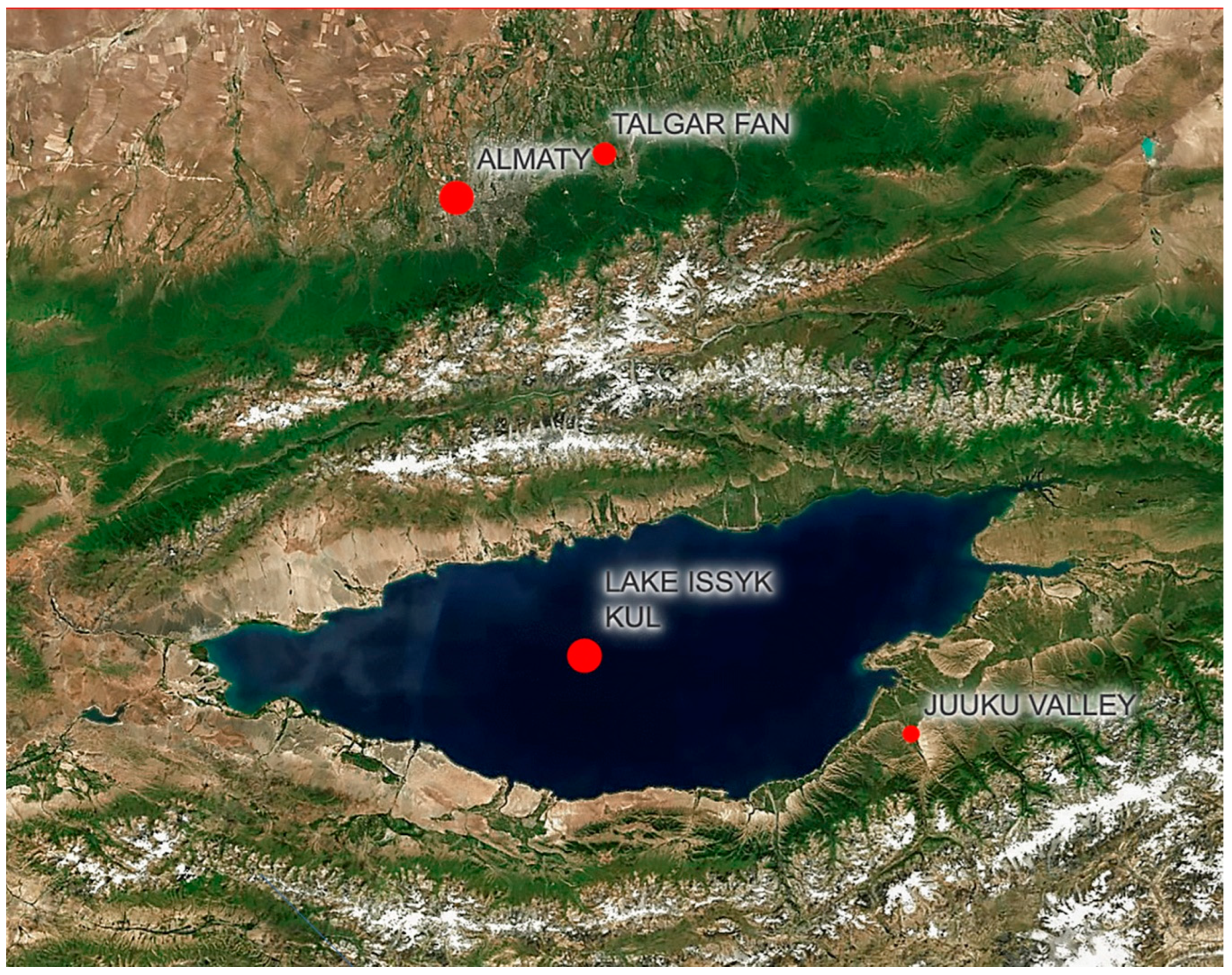
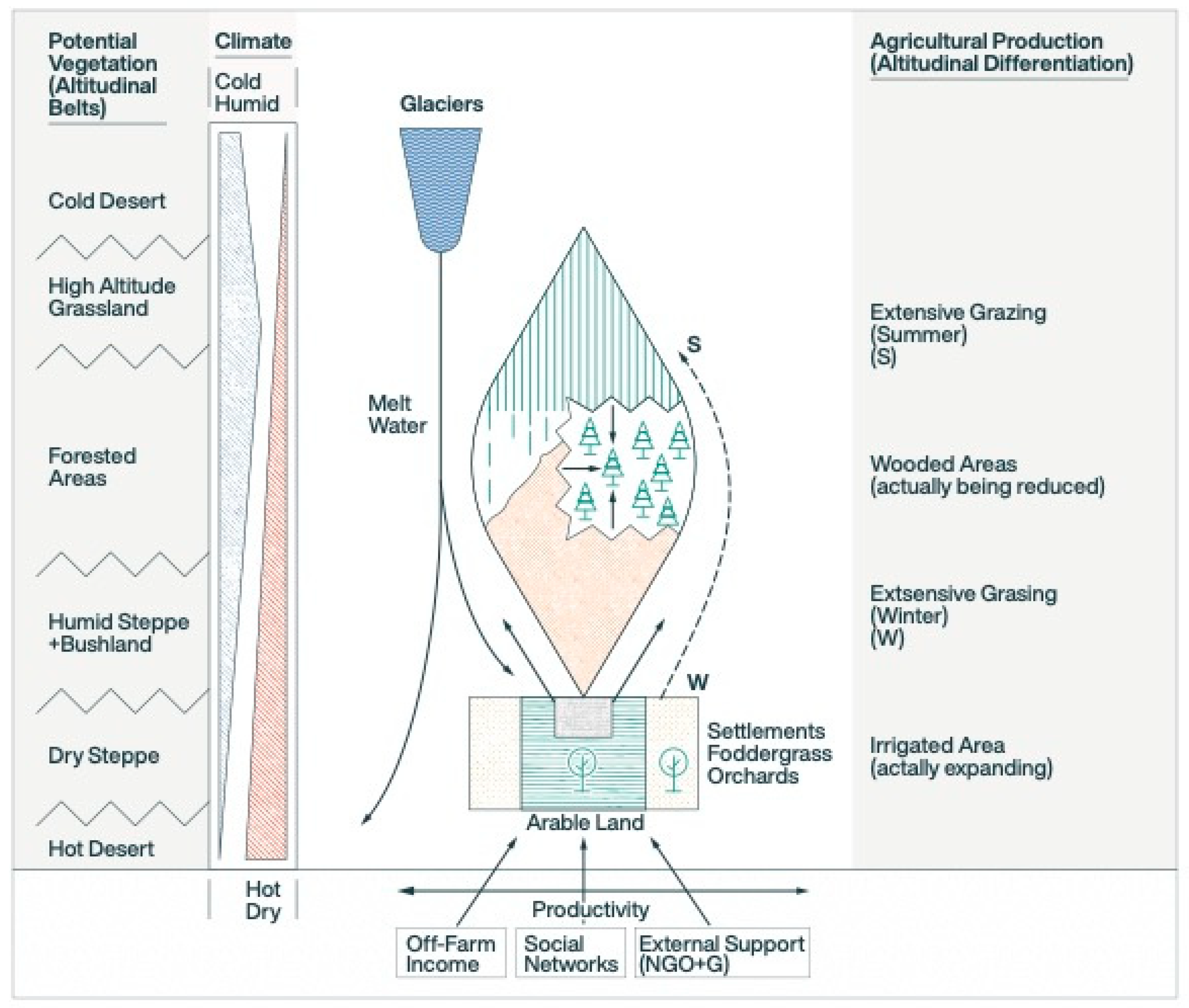
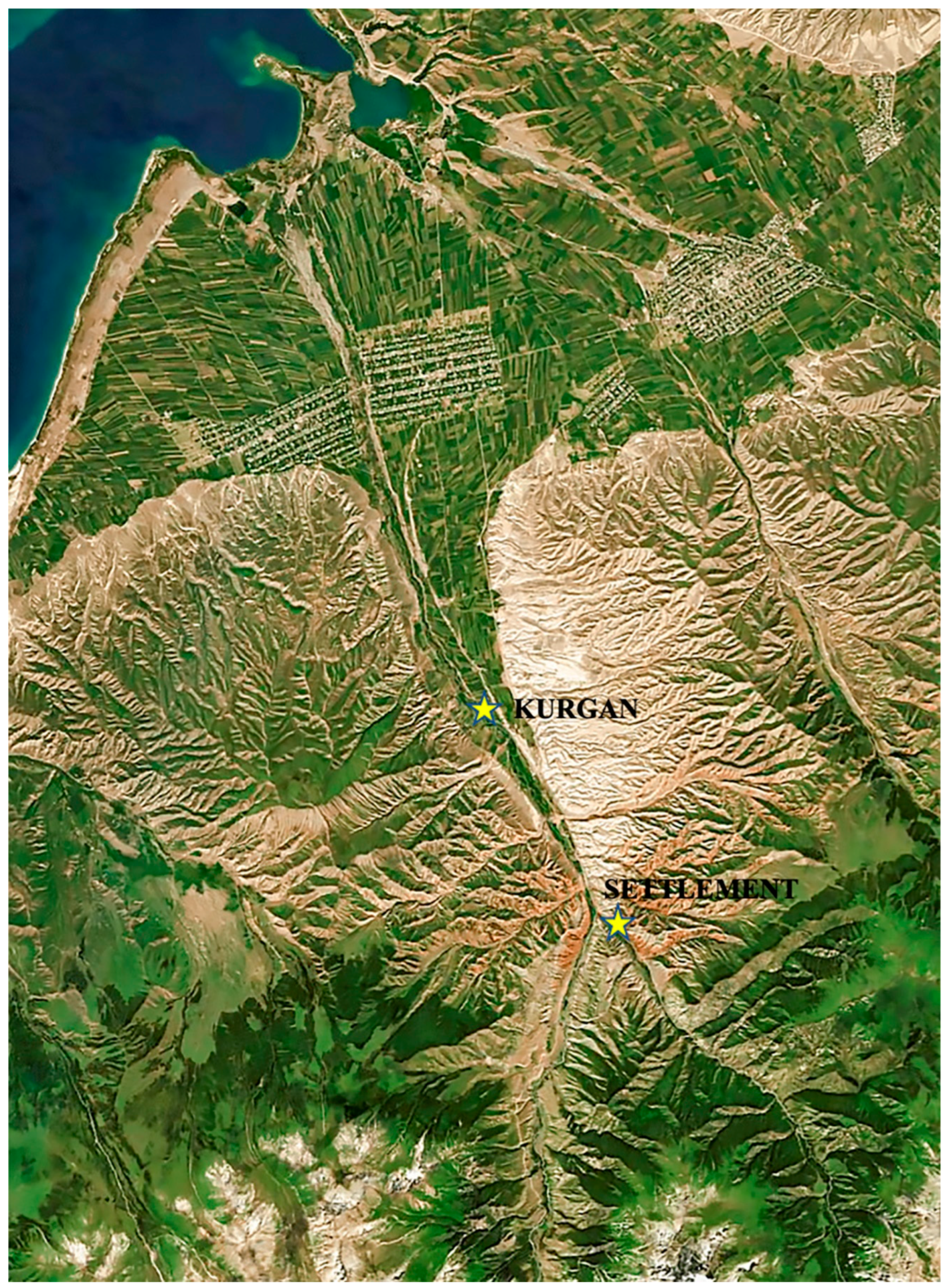
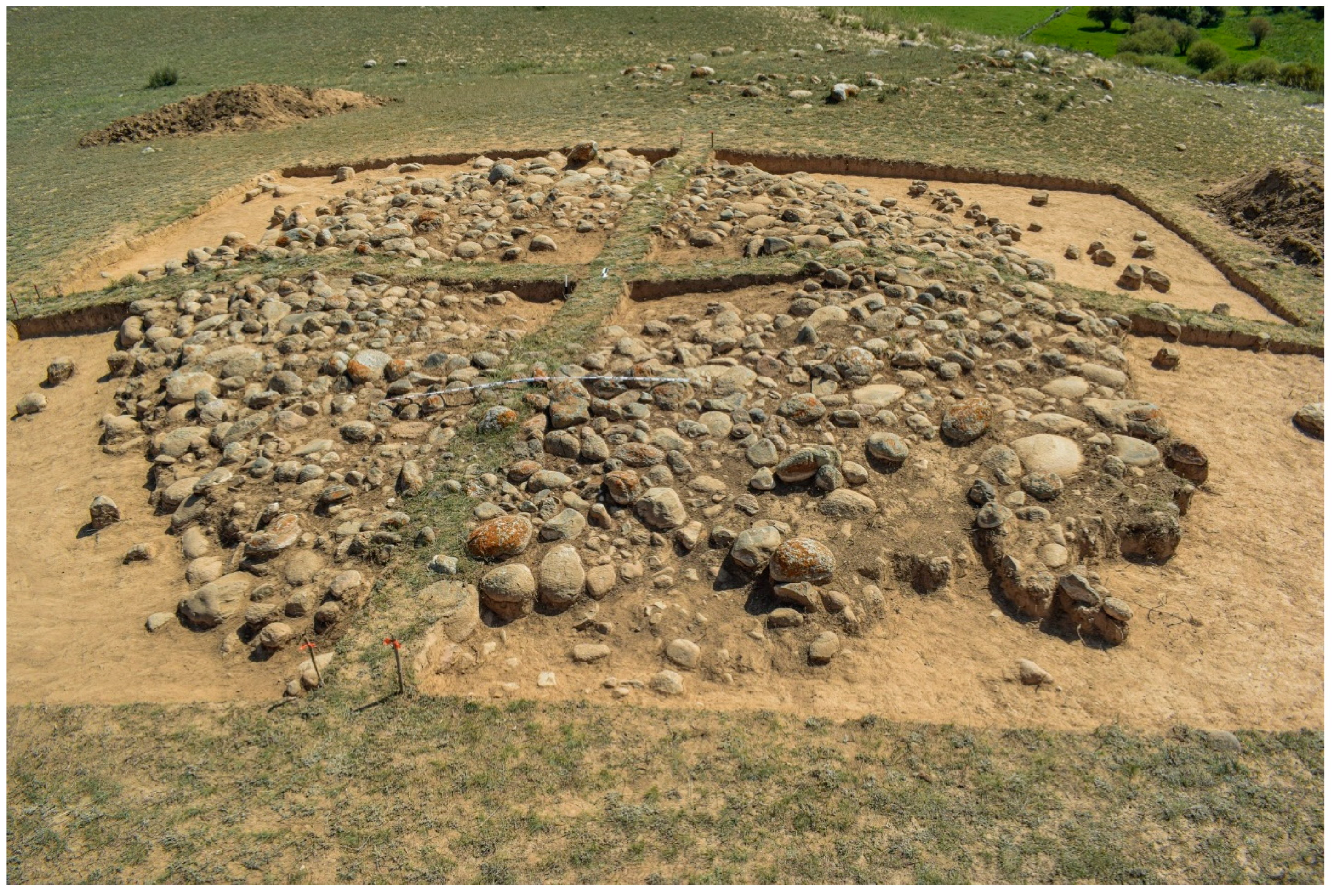
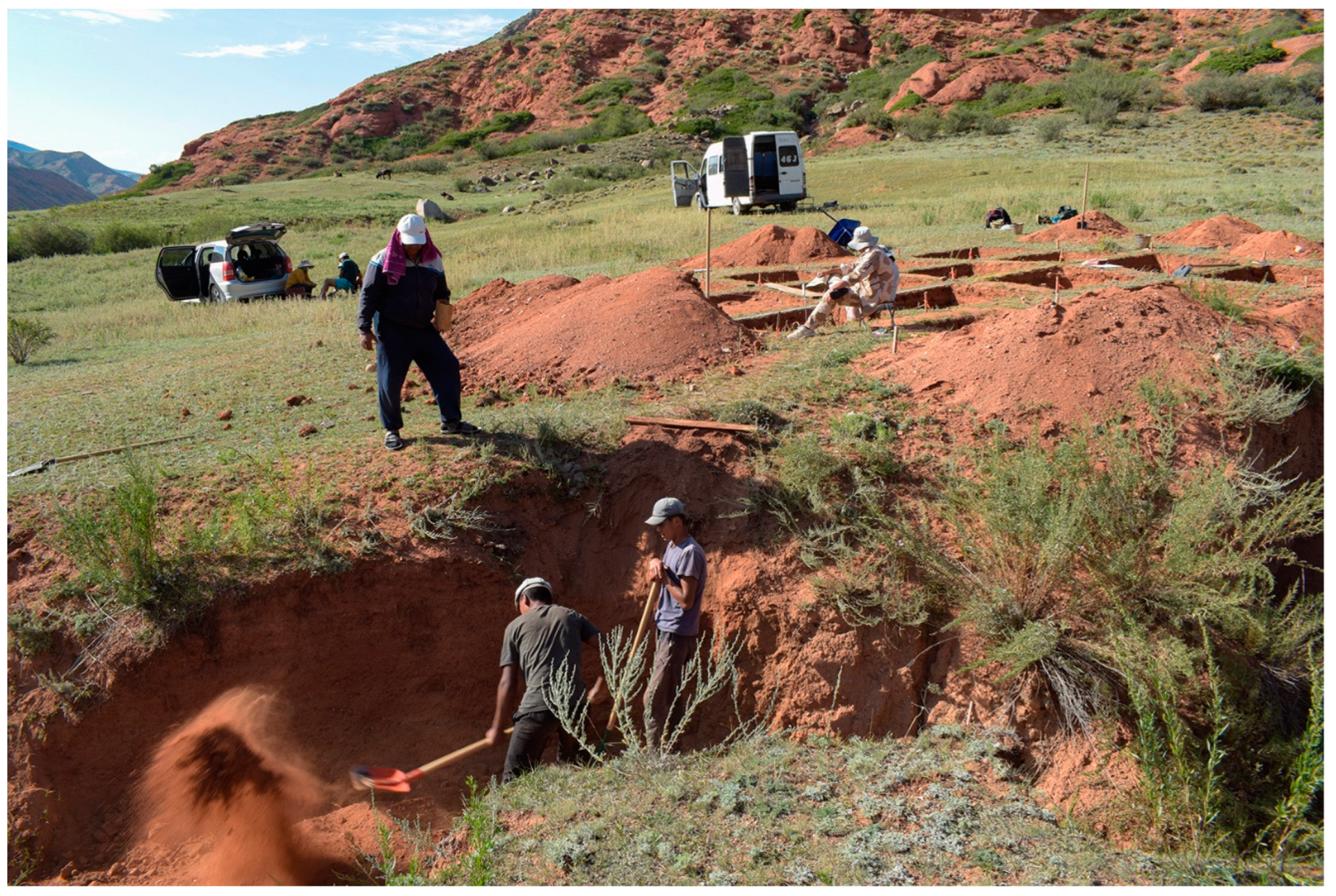
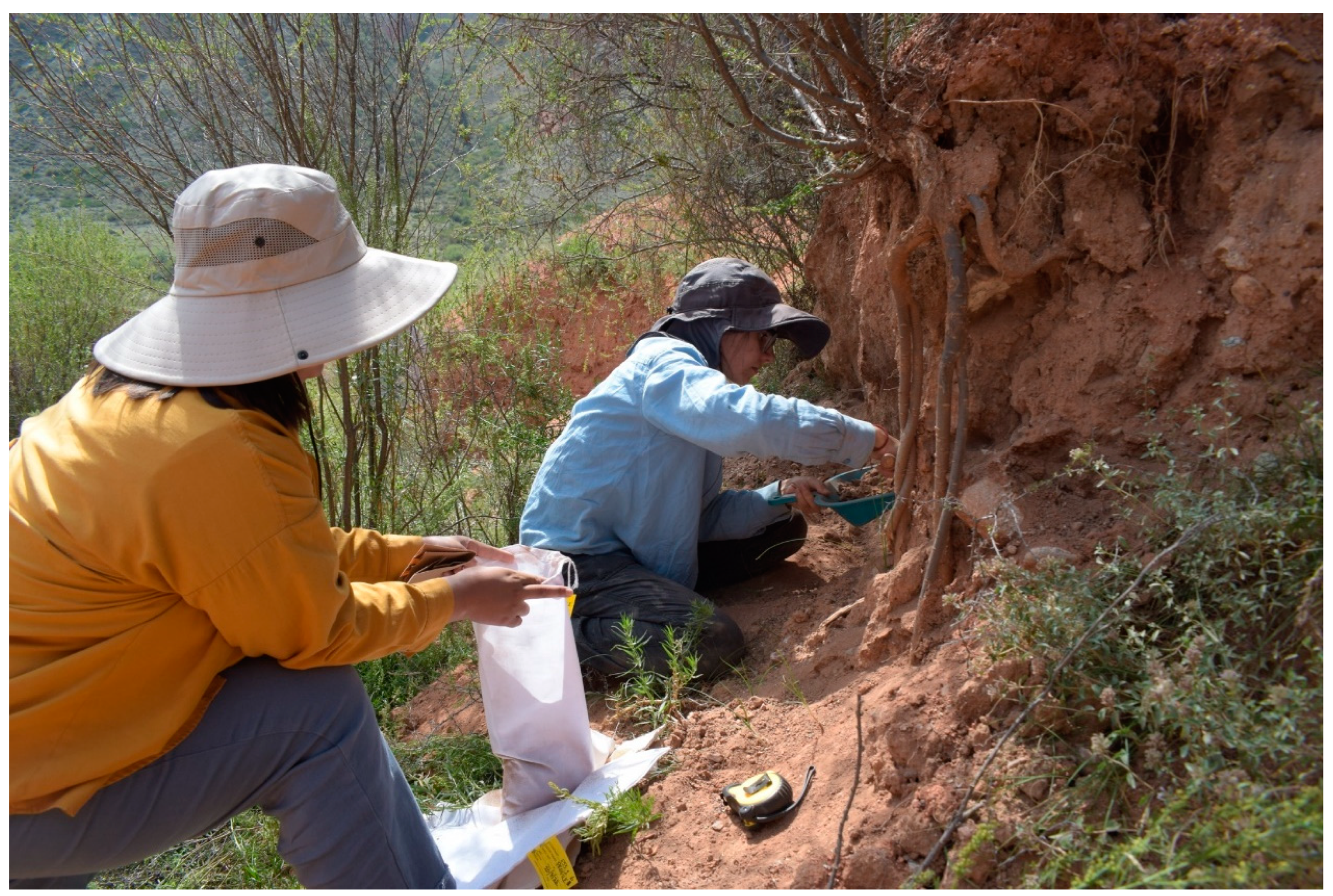
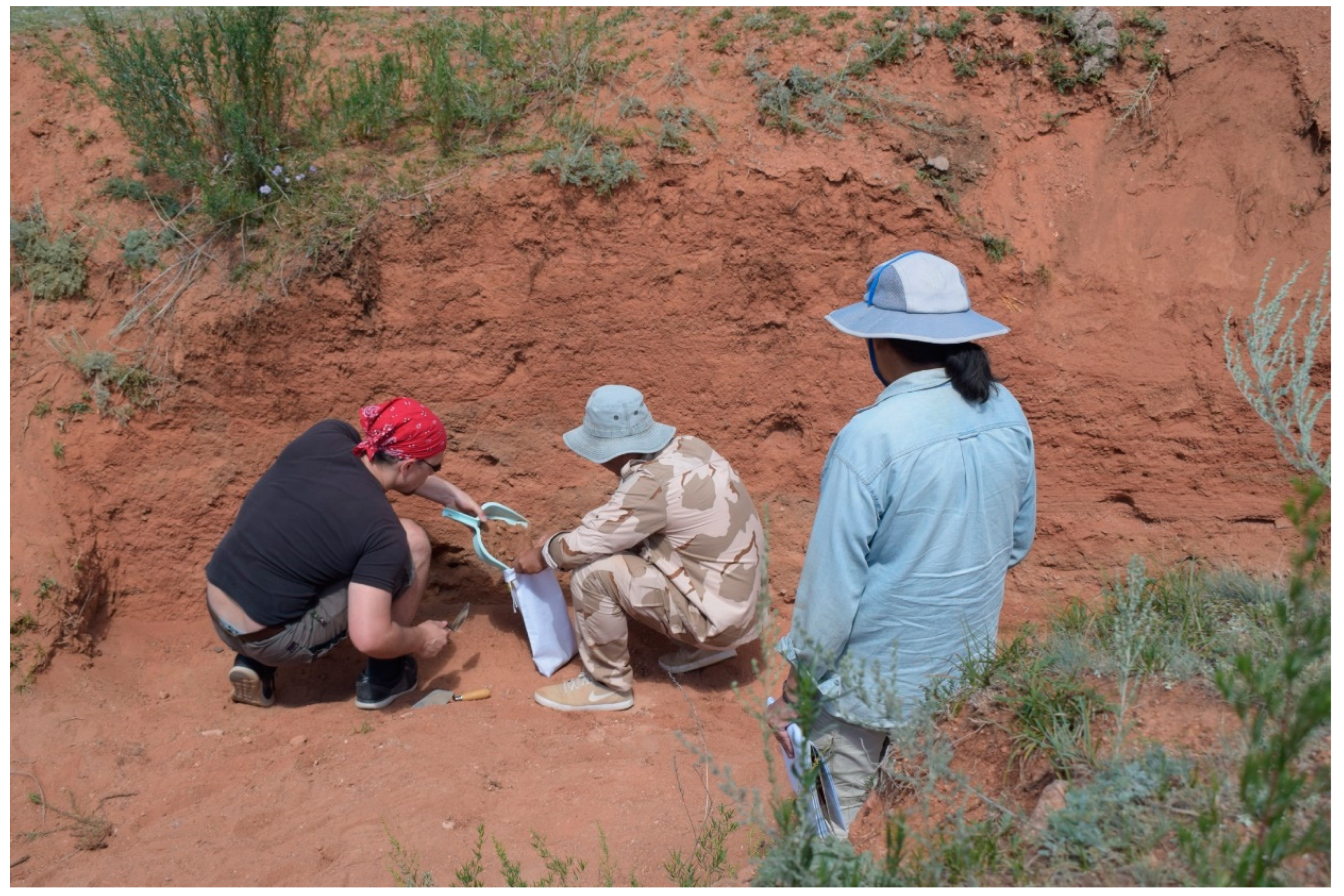
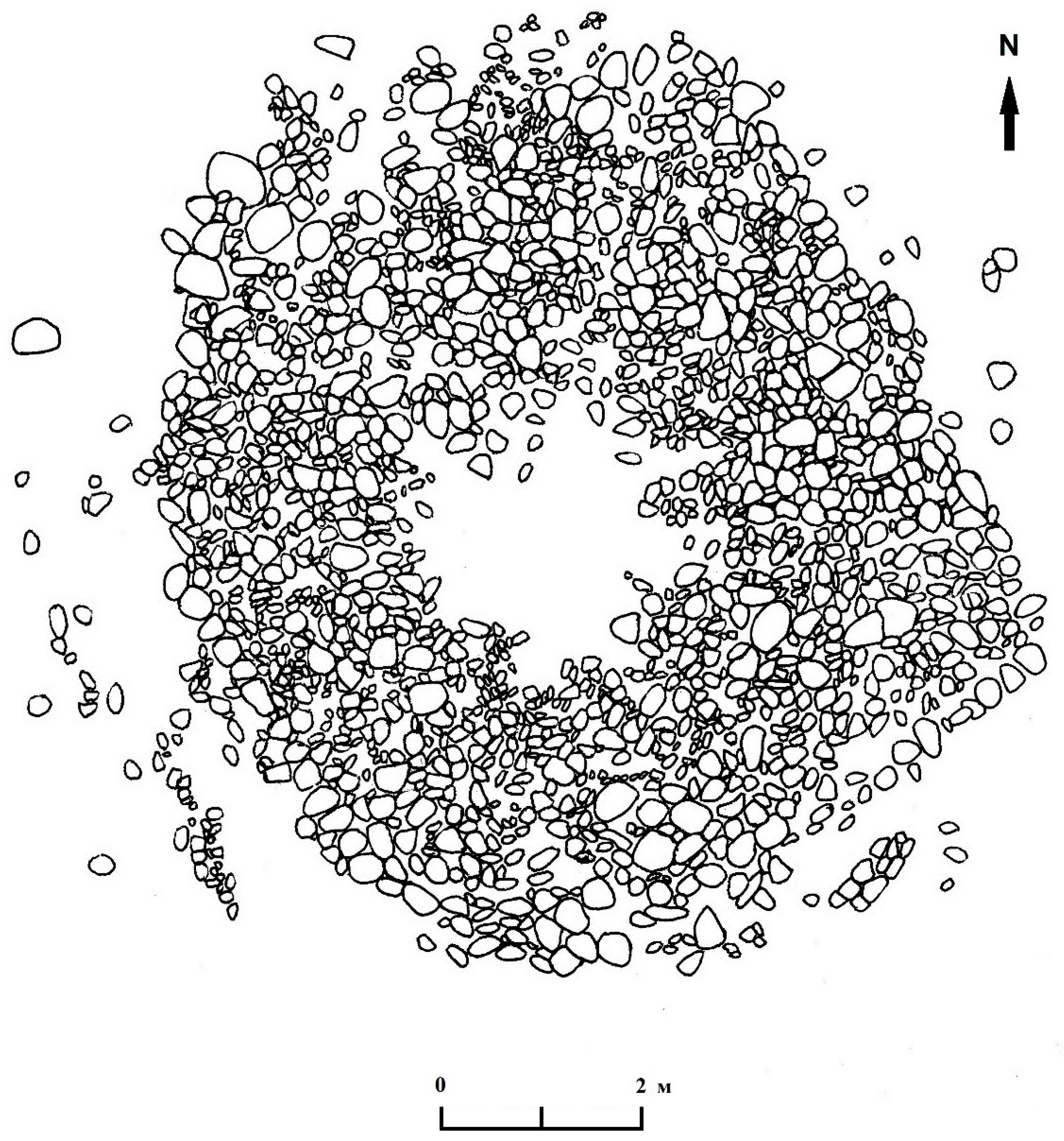
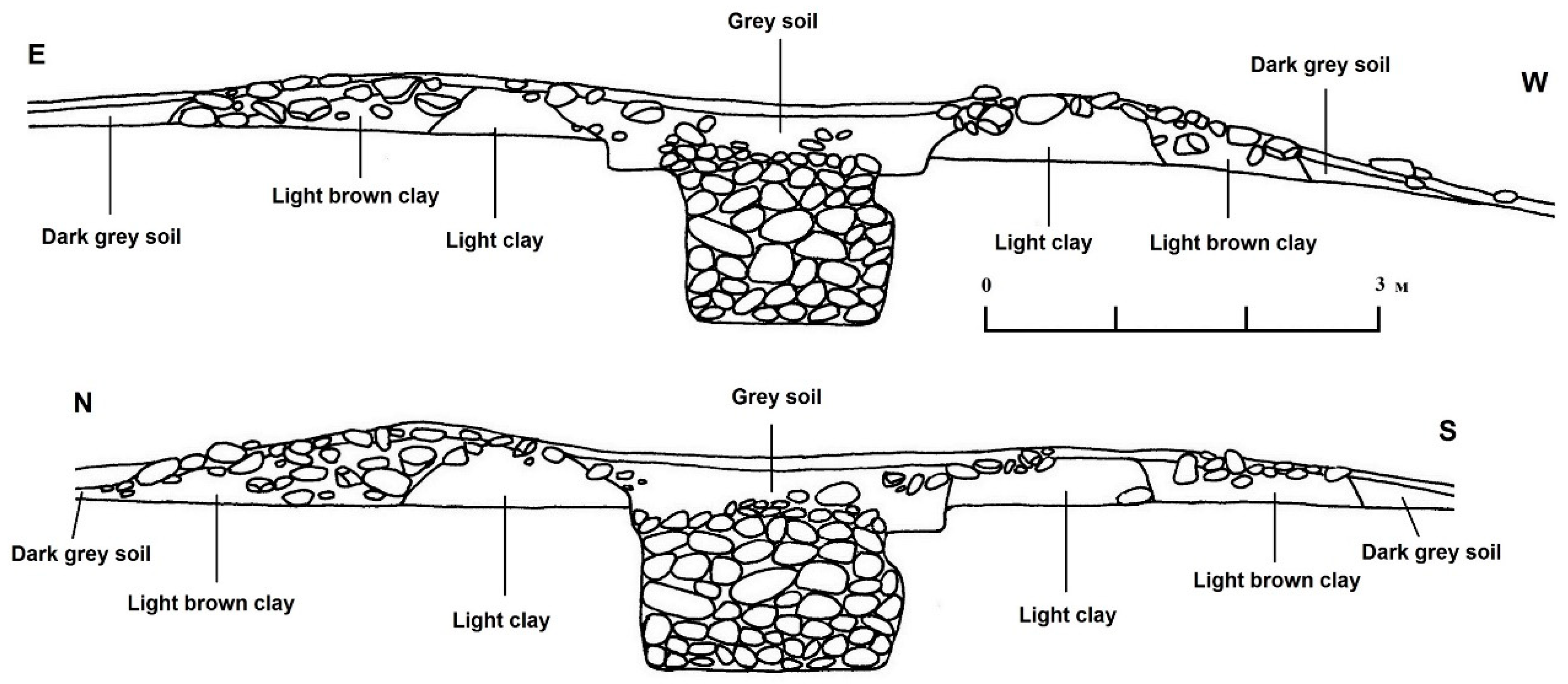
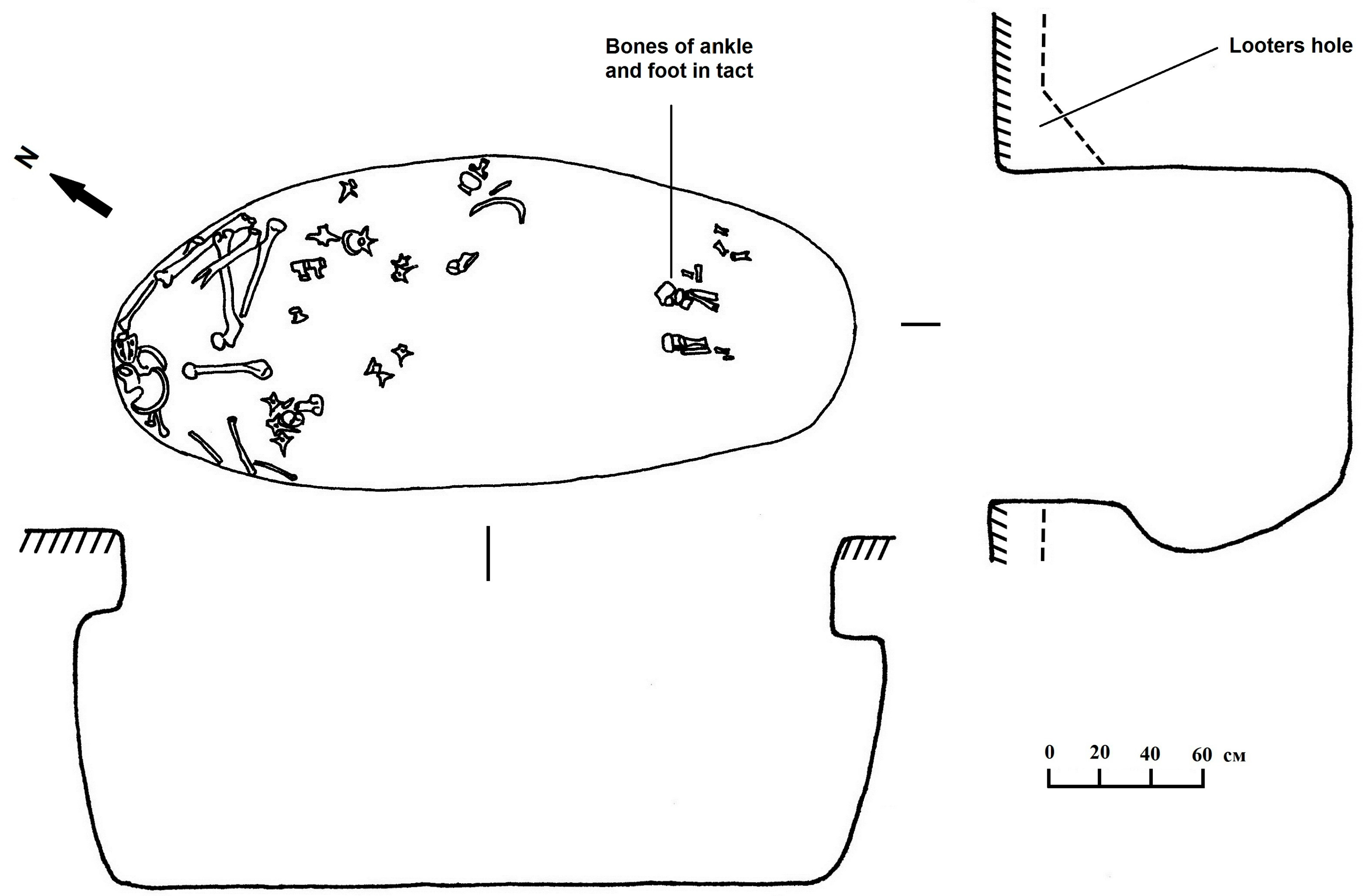
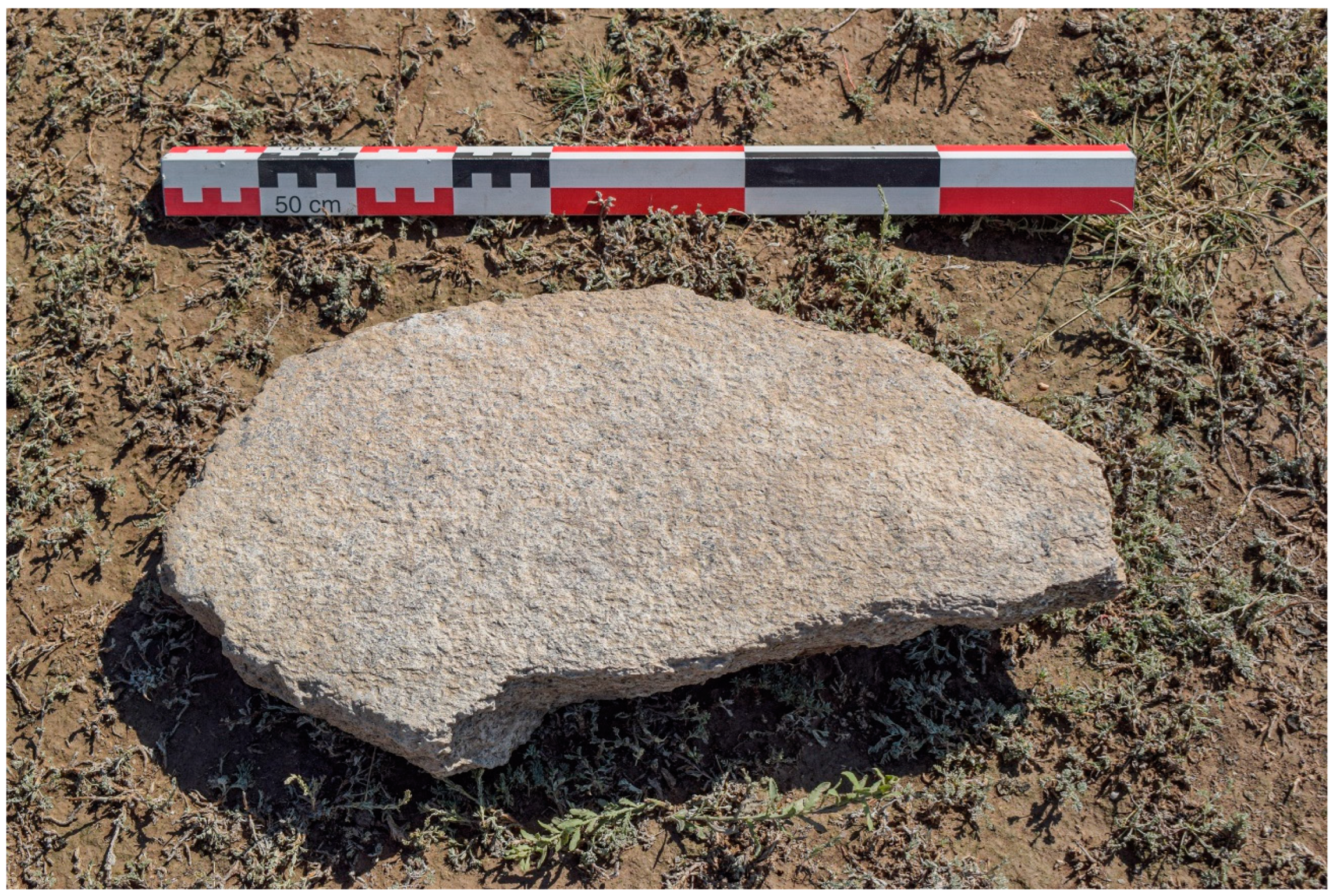

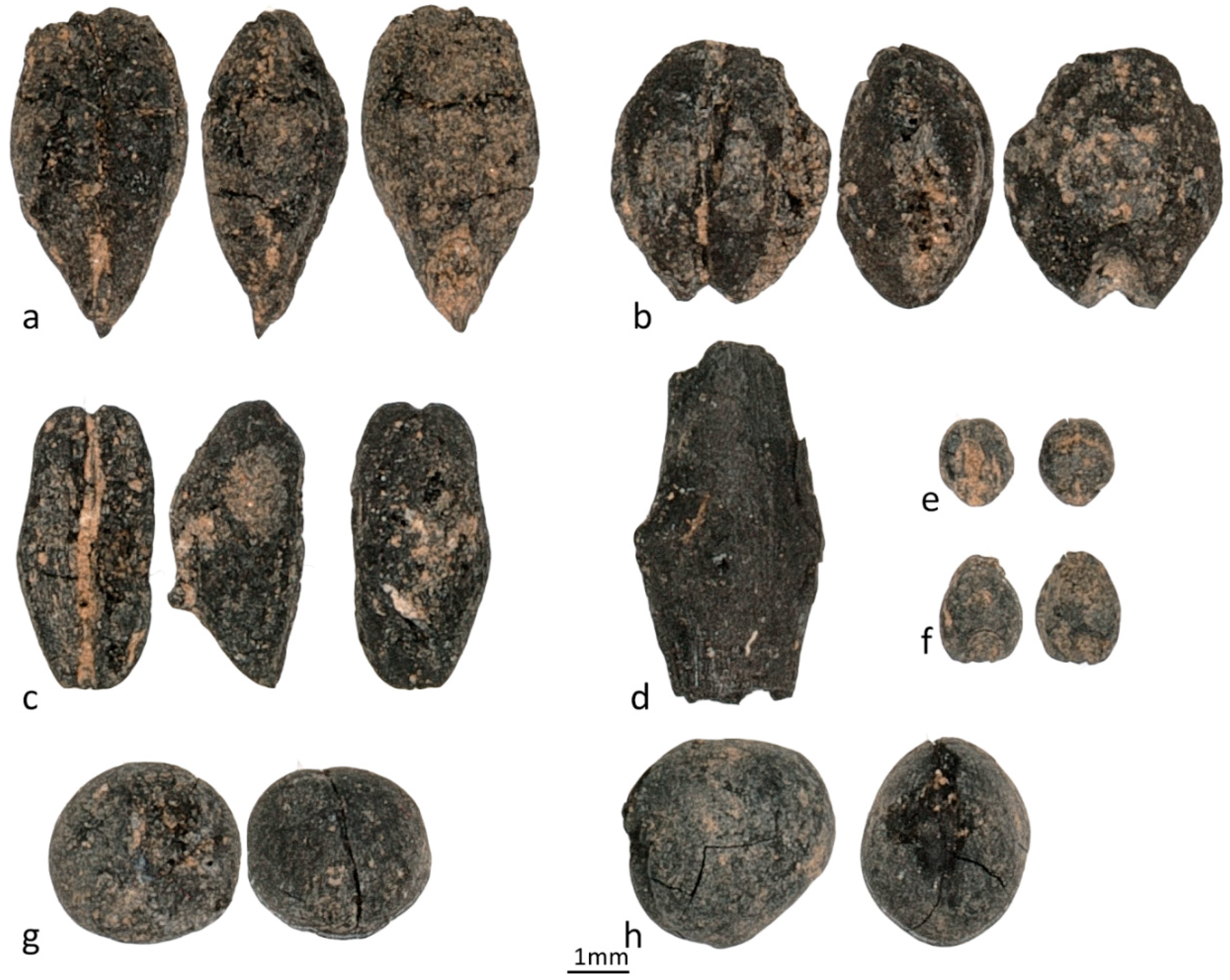
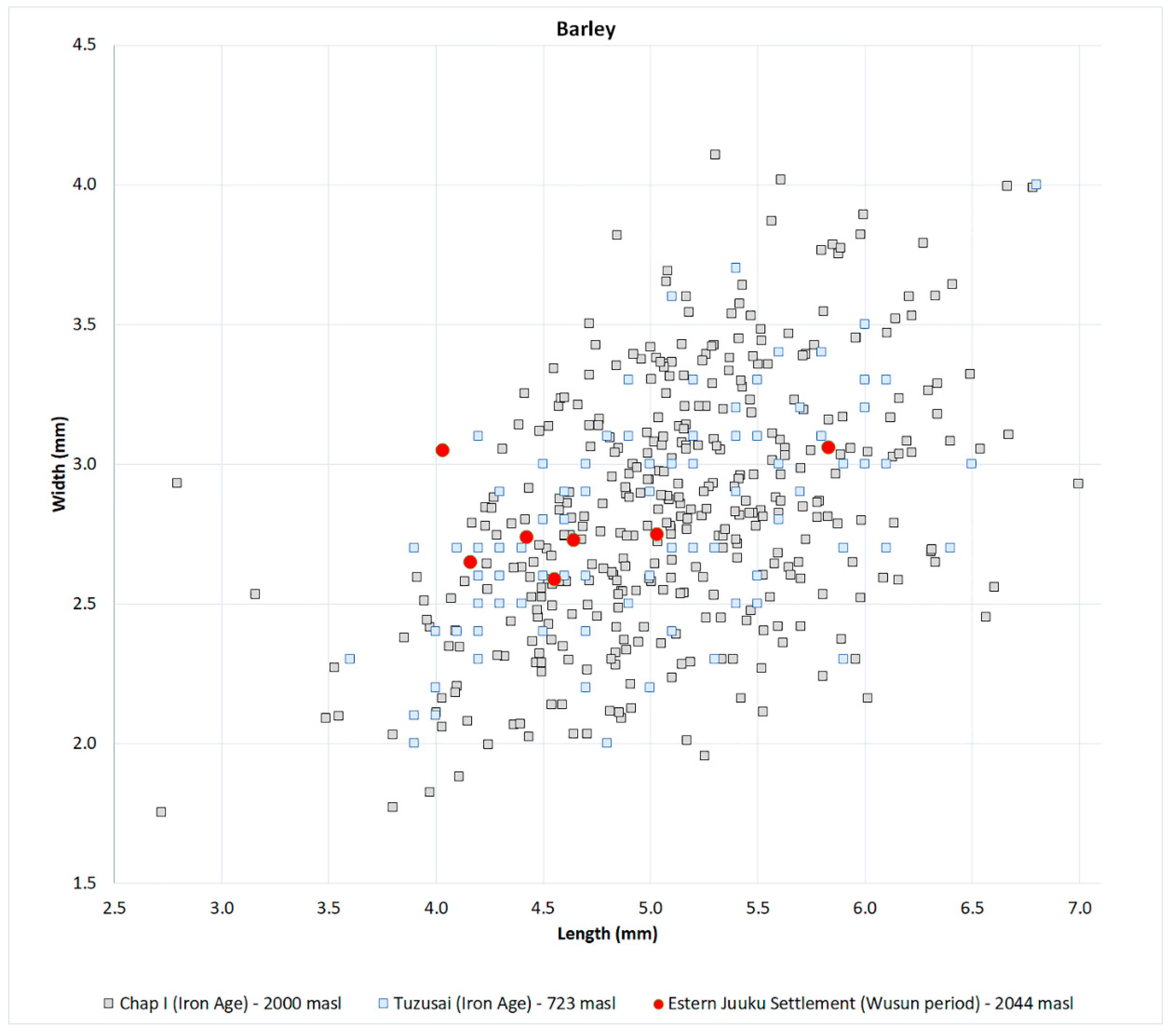
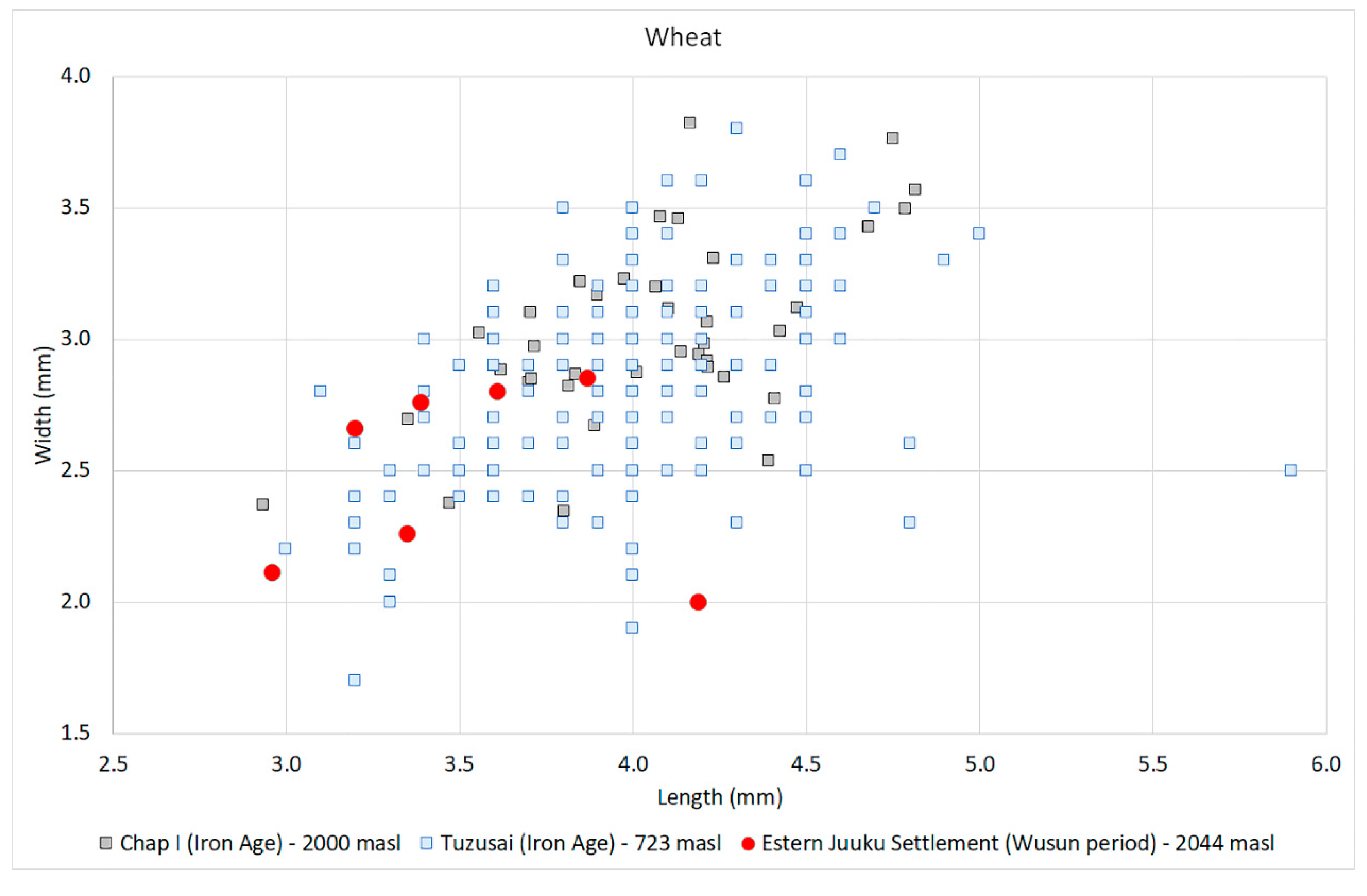
| Time Period | Phase Designation | Dates |
|---|---|---|
| Late Bronze Age | 2000 BCE–900 BCE | |
| Final Bronze | 1100 BCE–800 BCE | |
| Iron Age | 800 BCE–550 CE | |
| Saka | 800 BCE–260 BCE | |
| Wusun | 140 BCE–437 CE | |
| Kenkol (only in Tian Shan) | 200 CE–550 CE | |
| Medieval Period | 500 CE–1500 CE | |
| Turkic Period | 552 CE–900 CE | |
| Qarakhanid | 942 CE–1228 CE | |
| Early Kirghiz | 1500 CE–1700 CE | |
| Kirghiz Ethnographic Period | 1700 CE–Present | |
| Soviet Period | 1917–1991 | |
| Post-Soviet, Kyrgyz Nation | 1991– |
| # | Lab ID | Material/Pretreat | d13C o/oo IRMS |
Conventional Dates (BP) | Calibrated Dates at 95.4% (AD) | Settlement |
|---|---|---|---|---|---|---|
| 1 | OS-165284 | Wheat grain | --- | 1850+/-15 | 130-237 | Site-EJS1 Profile 1 |
| 2 | OS-165285 | Barley grain | --- | 1680+/-15 | 376-532 | Site-EJS1 Profile 1 |
| 3 | Beta-603779 | (charred material) acid/alkali/acid |
-22.7 | 1930+/-30 | 22-206 | Site-EJS1 Profile 1 |
| 4 | OS- 170789 |
Barley (Hordeum vulgare) | --- | 1860+/-25 | 125-237 | Site-EJS1 Profile 4 |
| 5 | OS- 170790 |
Barley (Hordeum vulgare) | --- | 1880+/-20 | 88-223 | Site-EJS1 Profile 6 |
| 6 | OS- 170788 |
Wheat (Triticum aestivum) | --- | 1130+/-20 | 882-991 | LJKurgan 1. Eastern part of intact wall |
| 7 | Beta- 654154 |
(charred material) | -23.7 | 1300+/-30 | 660-774 | LJKurgan 1 South part of burial pit |
| 8 | Beta-603780 | (charred material) acid/alkali/acid |
-25.3 | 1020+/-30 | 978-1151 | Site-EJS2 |
| 9 | Beta-603781 | (charred material) acid/alkali/acid |
-26.5 | 110+/-30 | 1682-1932 | Site-LJS1 |
| Depth from Yellow Clay Surface | Horse remains | Sheep/Goat remains | Cattle remains |
Unidentifiable fragments, animal | Human remains |
| 65 to 70 cm below surface | Horse molar | 2humerus fragments 1 tibia 1lateral malleolus |
1 radius |
5 skull fragments 10 fragments |
1 long bone fragment |
| Unknown depth | 1fragment radius/ulna 1 tibia |
4 fragments of large animal long bone 8 fragments |
2 vertebrae 7 fragments |
||
| Unknown depth | 2fragments radius/ulna |
5 animal bone fragments 1 calcine bone fragment |
7 fragments human bone | ||
| 150 cm below surface | 1 incisor horse | 1 molar 1 mandible 2thoracic vertebrae 1 calcaneus 1scapula fragment 4vertebrae epiphyses 1 premolar |
4tibia fragments | 88 fragments | 1 human Fibula 1 proximal phalange 14 fragments |
| Horse remains | Sheep/Goat remains | Cattle remains |
Unidentifiable remains |
| 1 rib | 1humerus fragment 1 molar |
1 rib 1 radius |
1tibia fragment 1 long bone |
| Total | Whole | Not measurable | Length (mm) | Width (mm) | Thickness (mm) | |
|---|---|---|---|---|---|---|
| Barley | 5 | 1 | 4 | 4.46 |
2.82 |
2.4 |
| Wheat | 2 | 1 | 1 | 3.3 |
2.21 |
1.78 |
| Total | Whole | Not measurable | Average length (mm) | Average width (mm) | Average thickness (mm) | |
| Barley | 13 | 4 | 9 | 4.61 |
2.88 |
1.69 |
| Wheat | 5 | 4 | 2 | 3.64 |
2.46 |
2.15 |
| Juuku-2022 | Total seeds | Domesticated | Wild specimens | ||||
| Phase | Volume | Absolute number | Density | Absolute number | Density | Absolute number | Density |
| Lower Juuku Kurgan (600 – 900 CE) |
31.5 | 14 | 0.44 | 7 | 0.22 | 7 | 0.22 |
| Eastern Juuku settlement (88 – 237 CE) |
93 | 114 | 1,22 | 26 | 0.28 | 88 | 0.94 |
Disclaimer/Publisher’s Note: The statements, opinions and data contained in all publications are solely those of the individual author(s) and contributor(s) and not of MDPI and/or the editor(s). MDPI and/or the editor(s) disclaim responsibility for any injury to people or property resulting from any ideas, methods, instructins or products referred to in the content. |
© 2023 by the authors. Licensee MDPI, Basel, Switzerland. This article is an open access article distributed under the terms and conditions of the Creative Commons Attribution (CC BY) license (http://creativecommons.org/licenses/by/4.0/).





